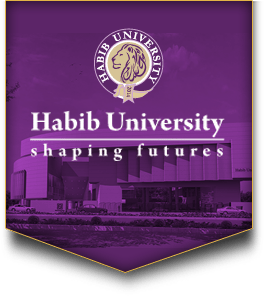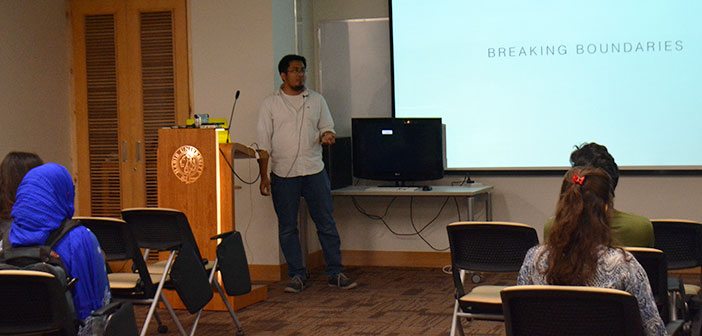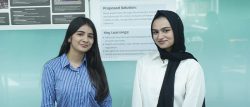The latest ‘Mulaqat’ event introduces the Habib University community to student Mohammad Hamza Alam, who blends art and science to be the best at what he does
HABIB UNIVERSITY, April 6, 2016: Habib University’s philosophy is to encourage students to think differently, challenge the norms, constantly explore their interests, and apply their learning on different projects and research: now, through different platforms, its students are encouraging their peers to share their best work and inspire and encourage others to be good at something too.
The ‘Mulaqat’ series of events, organized jointly by Habib University students and staff, is one such platform. Held at the University’s Raza Hussain S. Agha Multipurpose Hall, its latest iteration was titled ‘Crossing Boundaries’. It featured Mohammad Hamza Alam, a Communication Studies and Design major from the sophomore year. Hamza – whose interests are transdisciplinary in the truest sense of the word – used the platform to talk about how his two passions, computers and photography, shaped the choices he has made for his future.
After preliminary introductions, Hamza dived into an autobiographical account of how his childhood interest in technology led him to a pre-university career in computer science. Recounting episodes from his early life, Hamza narrated how he used to love playing with his uncle’s old, bricked phone as a child. During high school, he was also involved with six different startup ventures related to the field of technology. Among his accomplishments was software he developed to help his school streamline and catalog its operations.

Hamza’s Workstation at home
But computers weren’t the only thing that intrigued Hamza. “I caught the photography bug when the first camera phones came out,” he recalled. “I used to sneak out my father’s mobile phone to take pictures of anything and everything.” He recalled how he was nominated as his school’s official photographer after the principal discovered his talent in photography from a confiscated phone.

Hamza’s Photography
When “Habib University happened,” to use Hamza’s words, he was forced to make choices regarding what he would be studying for his undergraduate degree. His family was adamant that he pursue an engineering degree, but Hamza was unhappy with this decision: he also wanted to study the visual arts and their application in communication. In the end, his passion won out. “My father relented and told me to do whatever I wanted to do – but to do it better than anyone else,” he recounted.
Now enrolled in Habib University’s cutting-edge Communication Studies & Design program, Hamza still hasn’t let go of computer science. “The Computational Thinking course offered here at Habib University can teach you a lot about photography,” he explained. “I run logic statements inside my head when I’m taking a picture: for example, if ISO is XYZ, then aperture settings must be ABC, and so on.”
Commenting on how knowledge transcends disciplines, Hamza talked about how his understanding of physics helped fine-tune his photography skills. “If you’ve studied physics, you know how an optical lens works. And if you know how your camera lens works, you’ve already figured out quite a lot about photography,” he explained.

Hamza ended his talk with a few of his most outstanding works, including breathtaking portraits and nature photography, as well as a demonstration of his prized ‘Hackintosh’ – a Windows device that can run Apple’s latest iOS at the same functionality but less than half the price – which he has been working on over the past two years.
It is hoped that events like these will encourage more students to take on projects like the ‘Hackintosh’ while at Habib University. Opportunities for hands-on learning such as these, which Habib University actively strives to provide, allow students to apply their knowledge to the real world and see it in action, thus enriching their learning experience at university and beyond.




